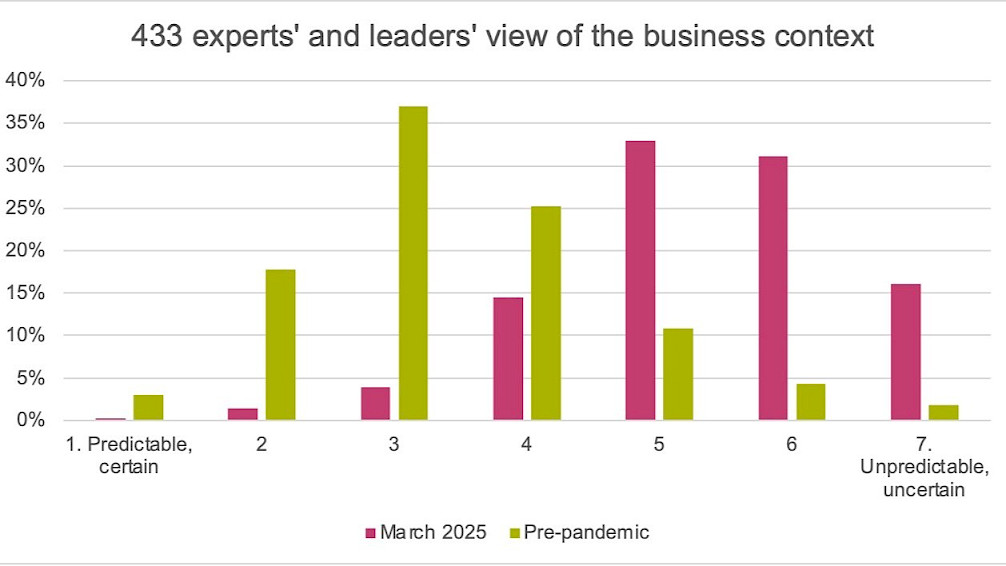Curiosity and Courage are the Core Assets in the New Normal
For more than 30 years, I’ve devoted myself to understanding “where we’re headed”, helping companies and organizations do the same – understanding where the world is going, how to relate to forces you can’t control (whether to sidestep them or ride the wave), and how to handle the things you can control.
Despite financial crises, the dot-com crash, new financial crises, and pandemics, we’ve never been close to the situation we’re facing today. The chart below illustrates this. It shows the results of a recent survey by Kairos Future in which 433 executives and leaders were asked how their organization views the external world today, and how they perceived it before the pandemic. Sure, memory can be deceptive, but the picture is illustrative – even if we only consider today's view of the world. Nearly half perceive it as extremely or very unpredictable and uncertain (6–7 on the scale), while only one percent says the opposite.

Twenty-five years ago, I wrote a doctoral thesis about the characteristics of companies that are successful at navigating this kind of terrain – what we now call BANI (Brittle, Anxious, Nonlinear, Incomprehensible), but which I personally prefer to call Raplex – rapidly changing, increasingly complex.
Be like a child – think and play your way into the future
My conclusion after analyzing just over a hundred companies in Northern Europe and the UK was that companies need to become more like children with good parents to succeed in a raplex world. If that was the case then, it’s even more important today.
I summarized my metaphor by saying that winners are skilled at:
-
THINKING – like a curious child constantly asking “why, why, why,” flipping perspectives, building and rebuilding their worldview.
-
PLAYING – not taking no for an answer, always experimenting, testing, learning through hands-on experience, drawing conclusions, and correcting mistakes. In short, they are brave and willing to push boundaries.
-
CULTIVATING – nurturing a culture that encourages and rewards these two mindsets and behaviors. And the leaders, as parents, are the gardeners.
Is compliance killing us all?
Since then, I’ve carried out numerous projects where this view has been confirmed time and time again – from global studies with hundreds of thousands of respondents to deep dives into specific topics. And the point is: the more BANI or raplex the world becomes, the more critical these behaviors are. They also stand in stark contrast to today’s buzzword of choice: compliance. When the hunt for rules and rule-following spreads into areas where it doesn’t belong, those rules become a wet blanket that suffocates most initiatives and causes the organization to land in the exact opposite of cultivation: dead and depleted ground.
What do you think? Is childish curiosity and playfulness the way forward? And what do leaders need to do?
How do you think about all this? Personally, I believe:
-
Foresight and external analysis are more important than ever – we need to have a crystal-clear picture of what’s happening in the market and where competitors, customers, technology, legislation, and more are heading. Here, AI can be an enormous help.
-
Decision-making processes must become more efficient, without sacrificing depth. We need better tools that help leaders and decision-makers both internalize AI-supported, data-driven decision materials to a greater extent, and reach shared conclusions that lead to real change.
-
Leaders who serve as role models in embracing uncertainty, new technologies and ways of working are more crucial than ever – leaders who encourage their organizations to constantly challenge ingrained thought patterns and routines. Leaders who don’t hesitate to break counterproductive or made-up rules that serve only those who invented them.
Do you want to explore how your organization can improve its foresight process? Or would you like to see what’s possible with a cutting-edge AI tool for contextual analysis? Don’t hesitate to contact me.
